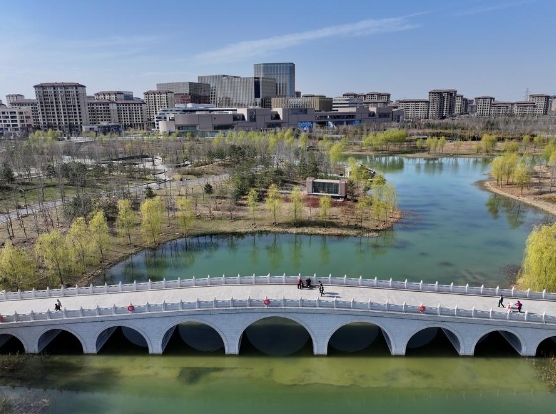China's "city of future" preserves tradition, nostalgia

An aerial drone photo taken on March 29, 2024 shows people enjoying themselves at Jinhu park in Xiong'an New Area in north China's Hebei Province. (Xinhua/Mu Yu)
As Xiong'an, China's "city of the future," swiftly erects new apartments, schools and hospitals, a lesser-known effort is unfolding in tandem: the preservation of historical artifacts, ranging from revered trees and weathered bricks to traditional cultural events.
Despite relocating to a new residence in a modern complex five years ago, Li Qiuhe still frequents a centuries-old locust tree in his former village of Xiaowangying, a cherished symbol of his roots.
"It shaded our yard, offering solace to my family throughout the seasons," Li recalled. "It holds deep memories of our childhood and the village we once called home."
In April 2017, China decided to establish Xiong'an New Area in north China's Hebei Province, part of a strategy to promote the coordinated development of the Beijing-Tianjin-Hebei region. Xiong'an was designed to be a smart and livable city that is innovative, green and free from "urban ills."
Around 120,000 residents like Li have been relocated from their old villages to new urban communities in Xiong'an. Within a 15-minute walk, amenities like bus stations, schools and elderly activity centers now enhance their lives with convenience and vibrancy.
Li's tree is among 2,360-plus "nostalgia points" registered by Xiong'an since 2018 when the local government initiated an effort to honor its past while constructing a new city. Amidst extensive construction, ancient trees stand undisturbed, while historic buildings and archways remain intact.
Li Taozhu, a former resident of Xiaowang Village who now lives in another urban community in Xiong'an, often takes his grandchildren back to the "nostalgia point" in his village. The spot is marked by several trees and the Temple of Guan Yu, an ancient general known for his loyalty and bravery in battles.
"I reminisce about my childhood memories of climbing jujube and locust trees and visiting the ancient temple," said Li Taozhu. "After all, this is where our ancestors once lived and we should not forget our past, even as we enjoy a better life."
In a storage facility dedicated to preserving nostalgic artifacts, not only are traditional fishing and farming tools unique to the Baiyangdian Lake stored, but also a considerable number of intricately carved old wooden doors and windows, stone pillars and bluestone slabs used in traditional house construction.
Like many rapidly urbanizing areas, Xiong'an grapples with the balance between modernity and tradition. The city's architecture incorporates elements of ancient porcelain, an ancient seven-stringed zither native to China, and historic seals.
Additionally, traditional rural markets continue to thrive, attracting locals who cherish their cultural roots. "In these markets, we find everything we need -- from fresh produce and meats to household essentials and clothing," said Li Taozhu. "It's a cherished tradition; even elderly women make the journey by bus to partake."
Xiong'an also embraces digital preservation, documenting old trees, houses and the daily lives of the local residents via video, photographs, virtual reality and other means, according to Chen Hui, deputy director of the publicity authorities of Xiong'an.
He Youshun, a 56-year-old shutterbug and former relocation office worker, bears witness to these shifts. Over the past seven years, he has captured over 100,000 photos encapsulating nostalgia and changes, ranging from quaint village scenes to time-honored crafts and vibrant cultural gatherings.
"I hope that more photography enthusiasts and photographers will join our shooting team and record more of the past," said He. "Documenting the construction of Xiong'an New Area is both an obligation and a responsibility for us photographers."
Editor:伏娅敏
